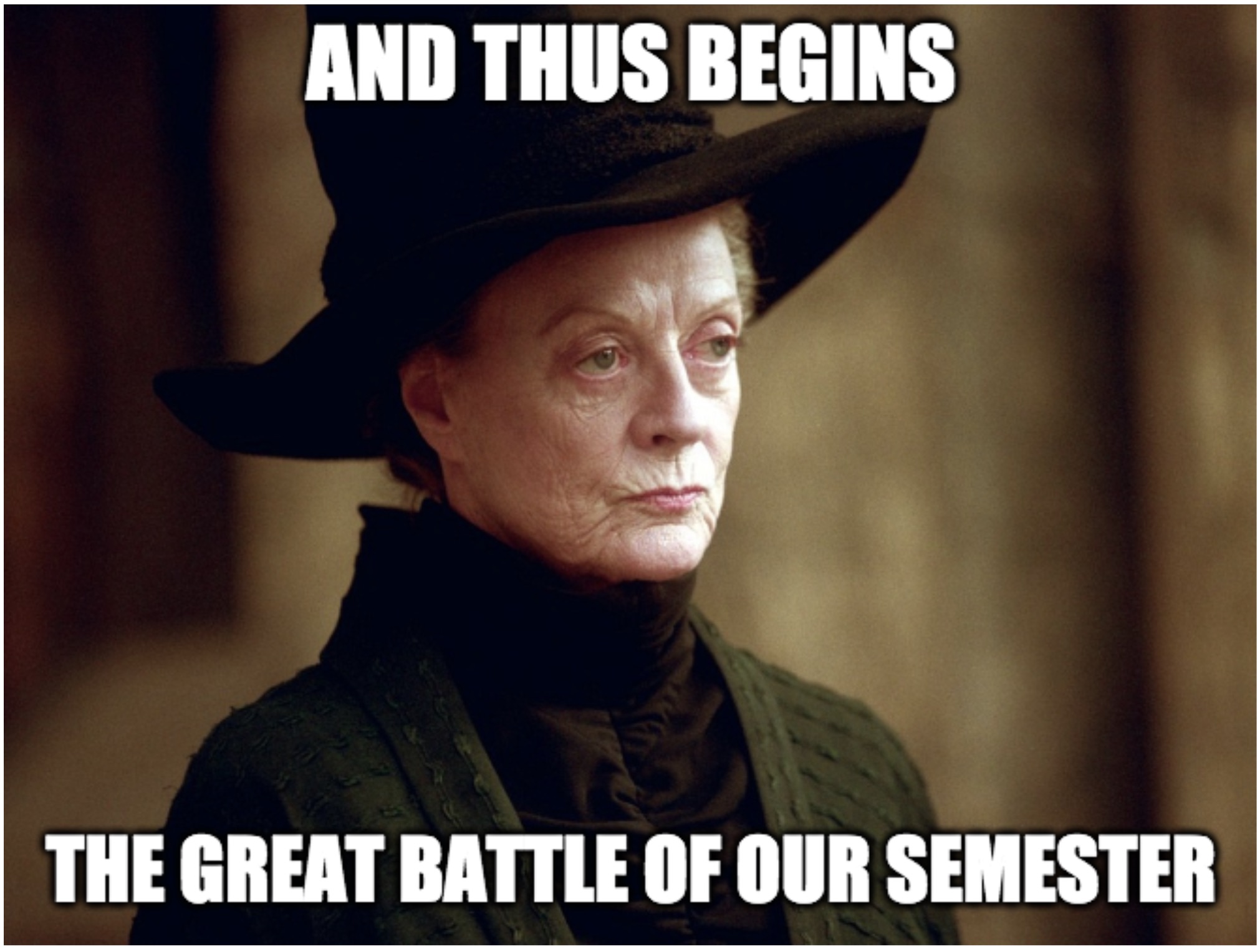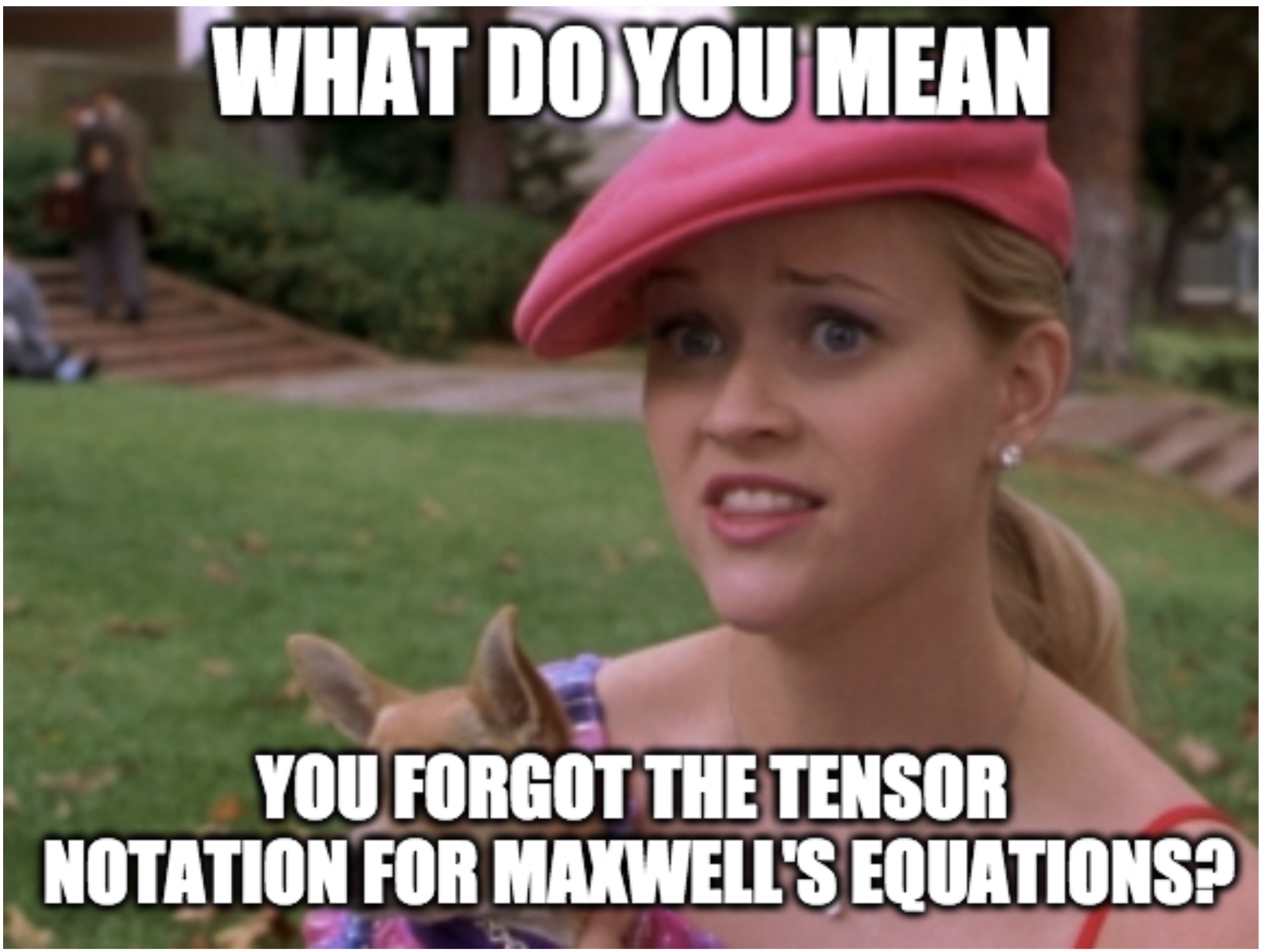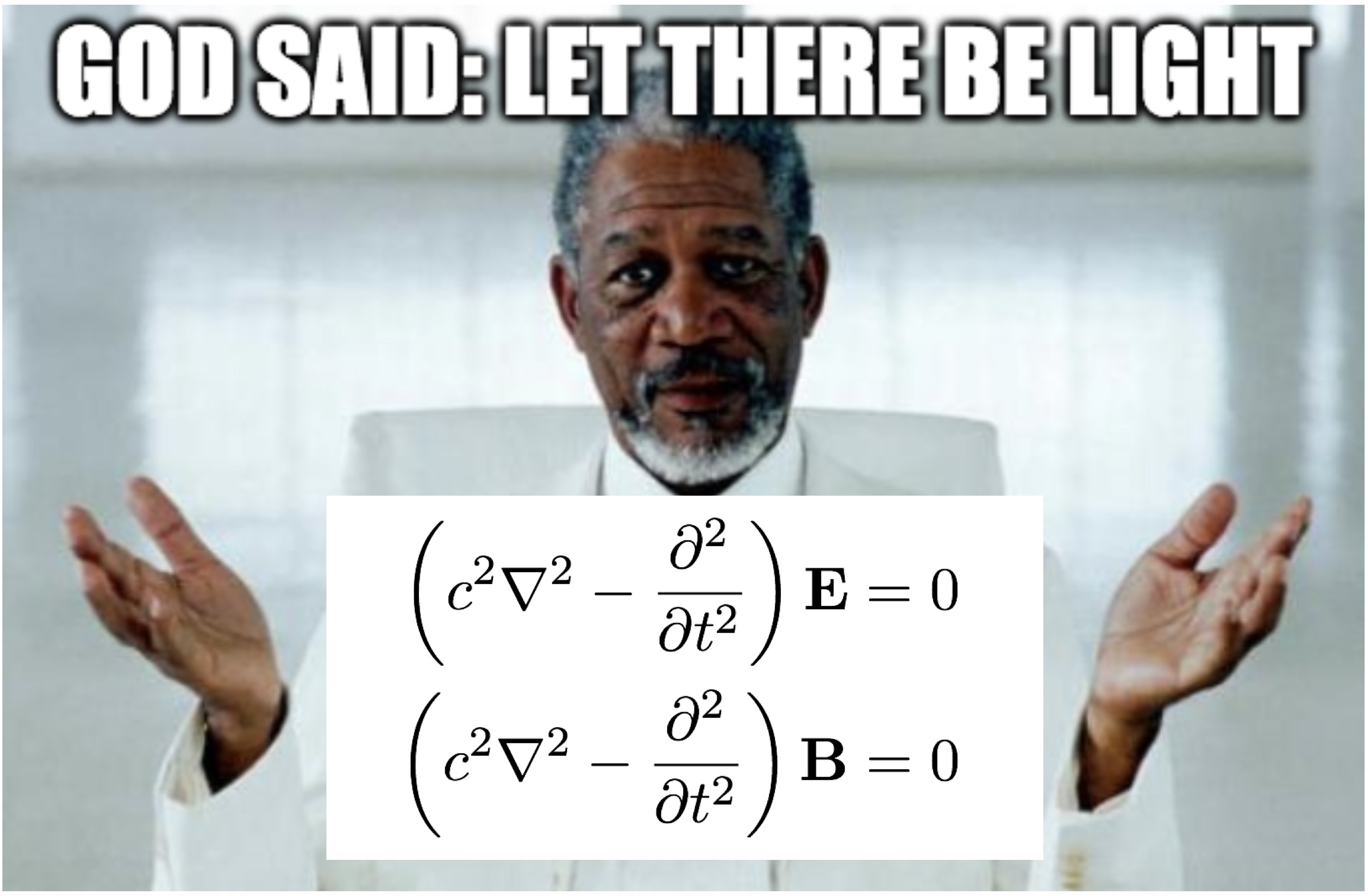
| Electromagnetic theory (AS.171.603)
(AKA Defense against the dark arts of quantum mechanics) Nadia Zakamska Spring 2025 |
| Course information |

1. Overview
This is a graduate course that covers relativistic particle dynamics, the fundamentals of classical field theory, radiation and propagation of electromagnetic waves, and Maxwell's equations in static and dynamic applications. Furthermore, we will discuss advanced topics in electrodynamics in medium and in plasmas and topics in current research. We will introduce analytical methods of EM theory (tensor calculus, partial differential equations and Green's functions and basis functions in several geometries, and if we have time also the linear stability analysis) and occasionally use scientific computing and visualization software for numerical calculations. The goal of the class is to equip students with foundations and tools necessary to read scientific literature and to conduct research projects in graduate-level physics.
Pre-requisites: an undergraduate course on Special Relativity (e.g., Chapters 1-6) and two semesters of undergraduate EM (Purcell and Griffiths). If you are a JHU undergraduate interested in taking 171.603, please email NLZ. This course is not a high-level version of the undergraduate course 171.301; it assumes strong familiarity with Griffiths (171.301) and contains qualitatively new material. Therefore, it is not a suitable replacement for 171.301.
2. Lecture schedule
Instructor: Prof. Nadia Zakamska
Lectures: tentatively Mon and Wed 12:00 - 1:15 pm in Bloomberg 259, but I will circulate a scheduling poll
TA / grader: Jackson Davis
3. Homework and grading
(1) There will be roughly one homework every four lectures (seven homeworks in total). You may discuss homework with your classmates or others. You may not look at their written solutions (and thus, you may not show yours to others). This policy covers the use of AI: you may not use AI solutions. Discussion and study groups are strongly encouraged; however, direct copying of assignments (including from AI) will be considered a serious violation of the homework policy. Please report any violations to the instructor (NLZ).
Group work: In previous semesters, group studies were very popular, and students reported high levels of satisfaction. The most successful groups met early in the homework cycle (as early as the day of the previous deadline to start working on the next homework!). If you anticipate that this course will be difficult for you, start talking to your classmates now to organize a group study. If you have strong preparation in electrodynamics, consider contributing to a study group to help your friends and to master the graduate material via teaching it. Good time management and starting work on the assignments as early as practical are key elements to success in this class.
(2) Neither the instructor nor the teaching assistant will answer any questions about the homework and there will be no office hours to discuss the homework. This is a deliberate policy decision by the instructor made in accordance with the expectations for self-guided study and work management in a graduate course. Past experience with the course indicates that students are interested in extra help with tensor calculus and relativity. Therefore, there will be two sections in the first month of classes where the TA will solve some additional example problems on tensor calculus / relativity. We are not planning any other sections beyond that.
(3) You may use Internet, books, journals, and departmental resources and software. Google is an excellent place to start if there are terms and abbreviations you don't know. If you use a webpage or an article in your final solution, please provide a reference. If you use a direct quote, you must put it in quotation marks and provide a reference. Your own words are always preferable.
(4) Unless specified otherwise, there is no need to type your solutions, but we need to be able to read your handwriting. Please write legibly, organize your solutions and highlight your answer. There will be some computational problems which will require students to code an algorithm and graphically display the results. Python is preferred (and solutions will be provided in python), but any computing language and platform are acceptable. Let me know as soon as possible if you cannot compute / visualize in any relevant language.
(5) Homework will be posted on Gradescope. There will be a 24 hour late submission window for every assignment. Gradescope automatically tracks late submissions. Please plan ahead and avoid submitting at the last moment in case of minor technical hiccups. Minor technical issues will not void the late submission penalty.
(6) Homework deadlines are strictly enforced. Everybody gets one free pass (per the entire semester) on one <=24 hour delay on a homework assignment. Aside from this, homework submissions late by 0-24 hours suffer a 50% penalty. Gradescope will not accept submissions late by 24 hours or more, so there is an automatic 100% penalty after 24 hours. Final exam grading penalty is one per cent grade reduction per each minute late. Assignments may build on each other, and we want to circulate the solutions as soon as practical. Therefore the best efforts in time management from all the students are necessary to make this a smooth experience for all.
(7) Final exam plan will be announced once we have finalized the schedule.
(8) The final grade is 1/2 homework, 1/2 final exam. From past experience, it is likely that the passing grade is over 50%. Therefore, it is not possible to pass the class without submitting homework.
(9) The instructor does not track lecture attendance and there is no attendance credit. However, because the course draws from a variety of sources, it is much easier to attend and take notes than to try to re-assemble the content of the lectures later. All lectures and the two sections will be recorded and posted on Canvas within a few hours of the meeting.
(10) All course materials (solution to homeworks, notes, additional resources) will be on Canvas. Registered students will have automatic access, and I have to enable access for informal audits on a person-by-person basis. All homeworks and exams will be through Gradescope. Access code for Gradescope will be posted on Canvas.
The strength of the university depends on academic and personal integrity. In this course, you must be honest and truthful. Ethical violations include cheating on exams, plagiarism, reuse of assignments, improper use of the Internet and electronic devices, unauthorized collaboration, alteration of graded assignments, forgery and falsification, lying, facilitating academic dishonesty, and unfair competition. The guidelines for this course are listed above. Report any violations you witness to the instructor. For more information, see the Homewood Student Affairs site on academic ethics, where ethics violations may also be reported.
Johns Hopkins University values diversity and inclusion. We are committed to providing welcoming, equitable, and accessible educational experiences for all students. Students with disabilities can request accommodations for this course by contacting Student Disability Services (SDS). Please request accommodations for this course as early as possible to provide time for effective communication and arrangements -- but please take a look at the syllabus first to see if your requests are already satisfied by the course setup.
4. Conventions
(1) A quick survey of the literature reveals that modern scientific convention (astrophysics, particle physics) is Greek indices for the 4D space-time and Latin indices for the 3D space.
(2) Since E and B transform into each other depending on the reference frame, "To measure E and B in different units is completely antithetical to the entire notion of relativistic invariance" (Melvin Schwartz). We will use the cgs system where E and B have the same units. We will discuss how to transform to other systems of units when necessary. In practice, PhD level physicists need to know both systems of units, plus additional field-specific systems. For example, most undergraduate physics teaching (and of course all engineering-related teaching) is in MKS, most graduate teaching is in cgs or other field-specific units, and research papers use unit systems interchangeably depending on the conventions of the field.
(3) As a physicist, you may need to do order-of-magnitude estimates of various physical effects. To this end, you must carry around in your head some fundamental constants of nature. This is a list of constants that students will find useful to know. These values can and do come up during questioning at the research exams, the GBOs, the thesis defenses and in your professional presentations.
5. Topics and textbooks
I highly recommend having Landau and Lifshitz volume 2 ("The classical theory of fields") and Jackson ("Electrodynamics") on hand for this course, but they are not required.
Additional pedagogical materials (PDF lecture notes and links to other resources) will be available on Canvas.
This course will not follow the standard Jackson syllabus (although there will be some overlap with Jackson). This is, roughly, the list of physics topics and the relevant mathematical apparatus we will discuss:
Part 1: Relativistic dynamics, 3D and 4D tensor calculus
Part 2: Classical field theory
Part 3: Electrostatics / magnetostatics, special functions in various geometries, Green's functions
Part 4: Generation and propagation of radiation in vacuum [I am trying to squeeze in advanced wave optics, if we have time]
Part 5: Propagation of radiation in media, dynamics of plasmas / dispersion relations [I am trying to squeeze in linear stability analysis, if we have time]
Parts 1, 2 and 4 are loosely based on Landau and Lifshitz volume 2 ("The classical theory of fields"). In terms of scope, we will cover their chapters 1-9 and in roughly the same order (although with less 4D formalism). Unfortunately, their index notation is different from ours (Latin instead of Greek for 4D).
Another useful source which gives some of the material in our Parts 1-2, but in a more accessible vector form and with more detailed derivations, is A.S.Kompaneyets ("Theoretical physics").
Textbook on Special Relativity by N. Zakamska, we will review material in Chapters 1-6 (undergraduate level) and introduce material in Chapters 7-8 (graduate level)
Part 3 will cover some of the material in Chapters 1-5 of Jackson's "Electrodynamics".
Part 5 is typically covered in advanced graduate plasma physics courses. I'll provide some notes and references.
We will also discuss topics related to modern research and modern analysis tools.
| Assignments |

Assignments will be posted on Gradescope, and after they are graded, the solutions will be posted on Canvas.
| Rough outline of lectures |

[References: LL - Landau Lifschitz with section numbers; NZ -- arXiv:1511.02121 with chapter numbers; AK - Kompaneyets with chapter numbers; JDJ - Jackson with chapter numbers; BT -- Binney and Tremaine with chapter numbers]
-- Part 1. Relativistic kinematics and dynamics
Lecture 1. Einstein's principle of relativity. Derivation of the Lorentz transform in a variety of ways. Refresher on standard applications of the Lorentz transforms: time dilation, length contraction. [LL 1-4; NZ 1-3]
Lecture 2. Tensor calculus in 3D.
Lecture 3. Kronecker symbols and anti-symmetric symbols. 4D invariants. Velocity transforms.
Section 1. 3D tensor calculus, special relativity.
Lecture 4. Tensor calculus in 4D, contravariant and covariant 4-vectors. 4-vectors of velocity, acceleration, energy, momentum, charge density. [LL 5-7, 9; NZ 5-7]
Lecture 5. Dynamics of relativistic particles. Motion in constant EM fields.
Lecture 6. Tensor of electromagnetic fields. Field transformations. [LL 6; NZ 7-8]
Lecture 7. Field invariants. [LL 23-25; NZ 8; JDJ 12] Probability density distributions and law of unconscious statistician. [LL 10, 11 and Wikipedia page]
Section 2. 4D tensors, relativistic particle dynamics.
-- Part 2. Classical field theory
Lecture 8. Scalar and vector potentials, charge conservation. Maxwell's equations in differential form.
Lecture 9. 4-potentials. Gauge invariance. Fields of moving charge. Maxwell's equations in covariant form. [AK 12; LL 18, 19, 26, 30; JDJ 12; Wikipedia covariant formulation is a really nice summary, despite MKS and a different sign definition in the Maxwell 3D stress tensor from the one we used].
Lecture 10. Maxwell stress tensor (3D), energy-momentum tensor (4D) [LL 31, 32, 33]
Lecture 11. Lagrangian for particles [LL 16, 17, AK 21], Lagrangian for fields [AK 13; LL 27, 32]
-- Part 3. Static solutions of Maxwell's equations
Lecture 12. Poisson and Laplace equation for fields and for the scalar and vector potentials and its Green's functions. [JDJ 1.1-1.7, 5.1-5.5]
Lecture 13. Multipole expansion [LL 40-44; JDJ 4.1-4.2, 5.6]
Lecture 14. Neumann and Dirichlet boundary conditions [JDJ 1.9], reducing Poisson equation to an ODE in orthogonal coordinate systems.
Lecture 15. Numerical methods [JDJ 1.13], general solution to Poisson equation through Green's functions [JDJ 1.7-1.10], separation of variables in Cartesian coordinates [JDJ 2.9]
Lecture 16. Separation of variables in cylindrical coordinates [JDJ 3.7, 3.8, 3.11]
Lecture 17. Potential of a charged disk [BT 2], separation of variables in spherical coordinates [BT 2, Appendix], CMB power spectrum analysis.
-- Part 4. Dynamic solutions of Maxwell's equations in vacuum.
Lecture 18. EM waves in vacuum. Tensor of polarization. [LL 46-50]
Lecture 19. Stokes parameters [Kosowsky astro-ph/9501045 and Wikipedia]. Spectral decomposition of intensity [LL 49]. Green's function for D'Alambert's equation [LL 62]
Lecture 20. Lienard-Wiechert potentials. Dipole radiation [LL 63, 66, 67]. Thomson scattering.
Lecture 21. Rayleigh scattering. Eddington limit. Multipole expansion for radiation.
Lecture 22. Cyclotron and Synchrotron emission.
-- Part 5. Topics in plasma physics and EM in media.
Flux freezing. E-cross-B drift.
Lecture 23. Drift of particles in Earth's magnetic field. Adiabatic invariant and magnetic mirrors. Dispersion of wave packets. Dispersion of EM waves in linear media.
Lecture 24. Dispersion of EM waves in cold plasma. Dispersion of EM waves in metals.
Lecture 25. Dispersion relation and optical properties of materials. Drude model.
Lecture 26. Kramers-Kroenig relations.
| Miscellaneous |

CGS vs MKS (scroll down for a conversion table for electromagnetic units)
Curvilinear systems (scroll down to the grey tables which are the most useful)
Latex template, style file and instructions
Garland -- Advice for beginning physics speakers